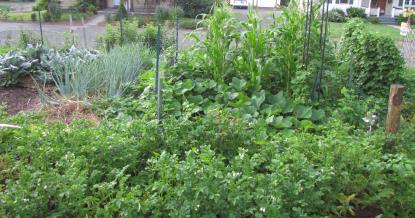July breaks the spirit of many gardeners. We fill the garden with seeds and seedlings in late May and June and wait enthusiastically for the first signs of life. In June we harvest greens and early vegetables. The beginning of July usually means fruits: peas, beans, raspberries, zucchini and cucumbers. Then old man summer takes away the punch bowl.
By the end of July our cats lie around the house on their backs attempting to increase their surface area so they’ll cool off. Even the chickens hide in the shade and raise their middle claw at me when I pass by. Insects move indoors to get out of the heat (sadly the Japanese beetles and striped cucumber beetles aren’t daunted by heat).
So all but the most stalwart of gardeners can be put off wading into the garden while drenched in sweat. A few minutes of weeding coats me in mud, sweat and mosquito bites. Sure it’s sexy, but not everybody wants to feel that way. This is the first reason that July breaks gardeners’ spirits.
But of course there’s more: in this most unpleasant of months heat loving plants shift into higher gear. Corn is especially well adapted to the weather. Unlike most garden plants, corn uses C4 photosynthesis. Without getting bogged down in the details, this means it can more efficiently synthesize sugar using less water at high temperatures. In July and August I see changes in the size of corn plants between the morning and evening. If you put your ear up next to them you can hear them growing; apparently it hurts.
Other garden plants have also started to grow quickly enough that many of my paths are obscured by watermelon, and butternut squash. Indeterminate tomato plants send shoots in every direction and I’m forced to tie and prune them more than once a week.
Despite my efforts with the mulch and assiduous weeding some of the weeds seem to sneak in overnight. This year one of the most apparent is crabgrass (Digitaria). Crabgrasses are also C4 plants and so can compete with little garden seedlings even better. I have noticed that my deeply mulched onion bed can suddenly get a six inch tall crabgrass plant that won’t let go. If I leave it alone, it will quickly dig its roots into the soil around my onions so that weeding essentially means having to harvest my onions. Crabgrass also invades the lawn if I fall behind on mowing. This summer “falling behind” means not mowing every sixth day: the combination of heat and rain we’ve gotten has been absolutely perfect for crabgrass.

The weeds then are the second reason we stay out of the garden. You stop weeding for a week when you go to the beach and upon your return the garden looks entirely overgrown. If you wade in, though, you will find that it’s full of cucumbers, beans, beets, carrots and soon tomatoes. Oddly the bounty can make one feel guilty: “I have to eat nothing but green beans for the next week because we have so much.” Don’t do that, your intestinal fauna might love it, but your partner won’t.
But we cannot give up now. A little extra effort in July means August and September will be filled with abundant fresh fruit. This is war dammit. Look those weeds in the eyes and go on in there and rip them out.


